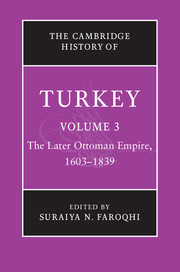Book contents
- Frontmatter
- PART I BACKGROUND
- PART II AN EMPIRE IN TRANSITION
- 4 Political culture and the great households
- 5 War and peace
- 6 Public finances: the role of the Ottoman centre
- PART III THE CENTRE AND THE PROVINCES
- PART IV SOCIAL, RELIGIOUS AND POLITICAL GROUPS
- PART V MAKING A LIVING
- PART VI CULTURE AND THE ARTS
- Glossary
- Bibliography
- Index
- References
6 - Public finances: the role of the Ottoman centre
from PART II - AN EMPIRE IN TRANSITION
Published online by Cambridge University Press: 28 March 2008
- Frontmatter
- PART I BACKGROUND
- PART II AN EMPIRE IN TRANSITION
- 4 Political culture and the great households
- 5 War and peace
- 6 Public finances: the role of the Ottoman centre
- PART III THE CENTRE AND THE PROVINCES
- PART IV SOCIAL, RELIGIOUS AND POLITICAL GROUPS
- PART V MAKING A LIVING
- PART VI CULTURE AND THE ARTS
- Glossary
- Bibliography
- Index
- References
Summary
In the post-classical period, the Ottoman central finance department’s primary role changed from supplying the household of the sultan to paying the military forces. The transformation of the army from a force of mounted bowmen with tax assignments (timars) to one of foot-soldiers with firearms moved the major burden of military support from the in-kind to the cash portion of the taxation system and put tremendous demands on the Ottoman budget. Even during the sixteenth century the number of people salaried by the state grew from 41,000 to 91,000, and during the seventeenth century it increased again; in 1630 military wages formed 77 per cent of the Ottoman budget, and in 1670 62.5 per cent. These demands were exacerbated by the price revolution of the sixteenth century and subsequent coinage devaluations. Since the military received quarterly wages, every three months the government had to hand out massive amounts of silver coin. But most taxes were paid on an annual basis, and because of the discrepancy between the solar and lunar calendars, every thirty-three years there was a lunar year in which payments had to be made but no taxes were assessed; in times of financial difficulty the resulting deficits were carried over from year to year. Moreover, many taxes were traditionally paid in kind. In the first half of the seventeenth century the finance department faced and met the challenge of altering the taxation system to a cash basis, although it was not able to solve the deficit problem until the eighteenth century.
- Type
- Chapter
- Information
- The Cambridge History of Turkey , pp. 118 - 132Publisher: Cambridge University PressPrint publication year: 2006
References
- 5
- Cited by



